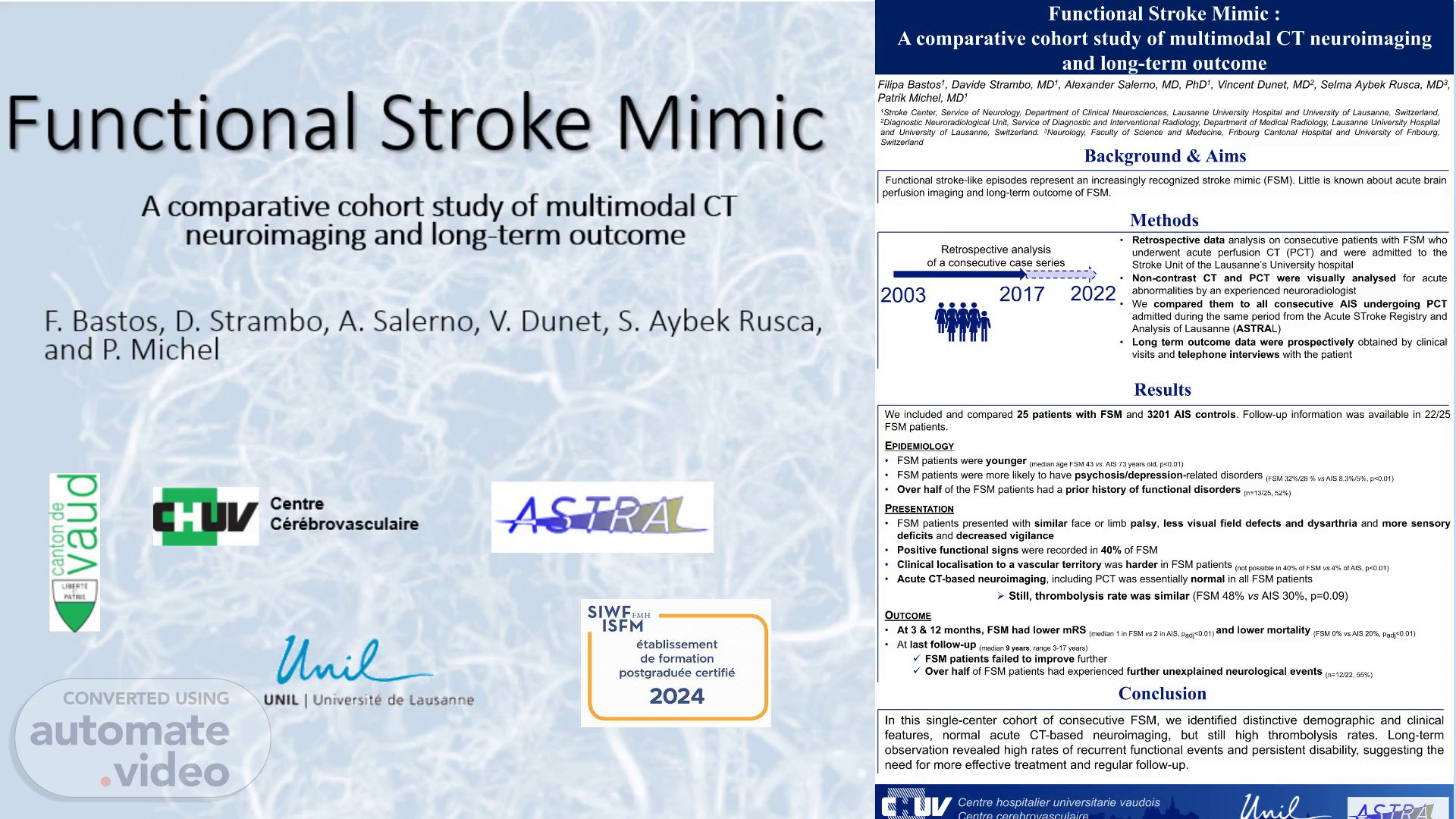Scene 1 (0s)
[Audio] Functional Stroke Mimic : A comparative cohort study of multimodal CT neuroimaging and long-term outcome. A work by Filipa Bastos, Davide Strambo, Vicent Dunet, Selma Aybek Rusca and Patrik Michel, from Lausanne's University Hospital, in Switzerland.
Scene 2 (1m 18s)
[Audio] Functional stroke mimics (henceforth FSM) are non-organic stroke like episodes. They're an increasingly recognized stroke mimic. While they differ from other stroke mimics and acute ischemic strokes they share common traits with other functional neurological disorders. Little is known about they're outcome and acute CT findings, features on which we focused in our study..
Scene 3 (1m 44s)
[Audio] We prospectively identified consecutive FSM adult patients who underwent acute perfusion CT within 24h of onset and were admitted to the Stroke Unit of Lausanne's University hospital between 2003 and 2017. As a control group we selected all consecutive acute ischemic stroke patients (henceforth AIS) who underwent perfusion CT within 24 hours after last well time, admitted during the same period from the Acute STroke Registry and Analysis of Lausanne (ASTRAL). Long term outcome data were prospectively obtained by clinical visits and telephone interviews..
Scene 4 (2m 26s)
[Audio] We included and compared 25 FSM patients and 3201 AIS patients. With regards to population characteristics, FSM patients were significantly younger and there was an overrepresentation of non-white ethnicity. With did not, however, observed any sex difference which contrasted to previous reports that found female predominance..
Scene 5 (2m 56s)
[Audio] Not surprisingly, FSM patients had less cardiovascular risk factors and prior history of cerebrovascular events. However, they were much more likely to have a history of psychosis/depression-related disorders. Interestingly, more than half of FSM patients had a history of prior functional disorders..
Scene 6 (3m 18s)
[Audio] Concerning clinical presentation, FSM patients had similar face or limb palsy, less visual field defects and dysarthria and more sensory deficits and decreased vigilance. Notably, positive functional signs (such as give away weakness, drift without pronation, Hoover sign, global pattern of weakness, unilateral facial lip pulling) were recorded in 40% of FSM and all but one patient had clinical inconsistencies which made it harder to clinically localise their deficit to a vascular territory..
Scene 7 (3m 58s)
[Audio] As to acute CT imaging, FSM had no acute natif CT changes and had significantly less chronic strokes and atherosclerosis. All but 1 FSM patients had normal PCT. Indeed, we found one patients had mild hemispheric hypoperfusion of unclear significance. We reviewd particuraly througly this patient's chart and are confident on the diagnosis of FSM. Indeed, this patiens presented with an awake witness onset of a waining and waxing hemisyndrome precceded and accompained by vegetative and pre-syncopal symptoms; There were no headaches or history of migraines. He had psychiatric comorbidities hand a history of multiple non organic complaints. His history and phyisical examinition were flutuating and MRI was normal..
Scene 8 (4m 49s)
[Audio] Despite clinical inconsistencies and virtually no acute CT abnormalities, acute revascularisation treatment rates were similar in FSM and AIS and considerably higher than previously reported. This raises questions about emergency physician's effectiveness in searching for neurological functional positive signs..
Scene 9 (5m 10s)
[Audio] Regarding outcome, there were no deaths at 12 months in the FSM population. At 3 and 12 months, FSM had lower adjusted Ranking score but this was not significant in a propensity matched analysis. Data on long-term outcome, obtained by telephone interviews at a median of 9 years after x event, were not encoring as it revealed that FSM patients failed to improve further and that over half of them had experienced further unexplained neurological events (mostly compatible with FSM)..
Scene 10 (5m 45s)
[Audio] To sum it up, FSM have distinctive demographic and clinical features but their acute recognition is changeling and requires specific skills and experience. Although the initial clinical course in FSMs may suggest a favourable prognosis, long-term observation revealed high rates of recurrent functional events and persistent disability highlighting the chronic nature of functional neurological disorders, of which FSM do not seem to be an exception. To improve patient care and management of healthcare resources, there is a need for more effective detection strategies to insure an adequate pipeline of care and follow-up for these patients..
Scene 11 (6m 26s)
[image] Une image contenant charpe Description g n r e automatiquement.
